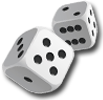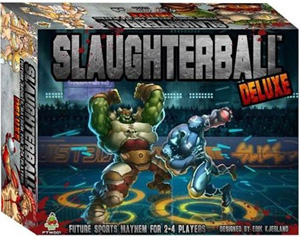



play board games
Board game reviews, strategy tips & session reports
Slaughterball Review
 Stats:
Stats:
No. of players: 2-4
Amount of time to play: 45-60 min
Age requirements: 10+
Set-up time: 5 min
Slaughterball is a sci-fi miniatures sports game that feels like a mix of basketball and hockey or football with some extra violence thrown in for fun.
Slaughterball Rules Description:
Slaughterball takes place over six rounds. Score the most points in that time and you win. You score points for goals, knocking players down or injuring them.
Each team has six players in the pit and there are four different roles a player may have. Butchers are really good at hurting opponents but not so good with the ball. Slashers are decent at both but better at dealing some pain. Cleavers are okay at both scoring and hurting but lean toward scoring. And Razors are much better at scoring than injuring opponents.
On your turn you may activate up to three of your players. When activated your player may take two actions in any order, but may not take the same action twice. You may only activate each player once per round. Play continues clockwise.
When you make checks you roll dice based on a certain stat. Two sides of the dice have on knife symbol and one side has two knife symbols. Each knife you roll is a success. For each opposing player you are adjacent to you lose a die from your check. You don’t lose a die for the player you are chopping and you can always roll one die.
The actions you may take are move, shoot, pass or chop. When you choose to move, you move your player up to its speed value. Generally the better you are with the ball the faster you move. If you started your turn on the ground you must move and just get to stand up.
Shooting requires an accuracy check. To make a goal you must roll a number of successes greater than or equal to the number of spaces between you and the goal. You score points equal to this distance. So if you are six spaces from the goal and score you get six points.
A pass adds the thrower’s accuracy to the catcher’s agility. If you roll a number of successes equal to or greater than the spaces between them the ball is caught. Catching does not require an action.
The chop action makes your opponents bleed. Well if you roll enough successes it does. This is an opposed check. You and the coach of the player you are chopping roll dice equal to their player’s brawl skill. Whoever rolls the most successes knocks the other player down. If the number of successes exceeds the player’s toughness they are injured. Knocking an opponent down scores one point, injuring them scores more depending on their position. Hitting players that have been knocked down is a foul.
Coaches have five cards that can boost a player’s stat for an action, send a fouling player to the penalty box or let a player return to the pit after an injury or penalty. And some cards allow you to interrupt another player’s turn, to carve a player (which is chopping them for moving adjacent to you) or give them a penalty for hogging the ball.
If a goal or pass is missed you scatter the ball. The coach in last place rolls a d8 and places the ball in an unoccupied space up to that distance away from the goal or catcher.
These above rules are for scrimmage games. You can also play exhibition or league games. The four teams have some unique abilities in these modes. Some special abilities are available to make more dice sides successes. You may also score points by throwing the ball at an opponent and knocking them down or injuring them. In leagues you can hire Mavericks (MVPs), support staff and add new skills to your players.
A Quick Review of Slaughterball:
Slaughterball is a fast-moving, high-scoring sports miniature game. It plays well with two to four players and keeps everyone engaged. It feels like a mix of DreadBall and Blood Bowl. It feels lighter than both of them and therefore might be more accessible.
The components range from ok to very good. The game looks good on the table and the miniatures really standout. The bright colors mean you know the teams and don’t have to paint them, but you can. The art and graphic design is less impressive. Some of it is nice but it is not consistent. The rulebook is very well done. It is easy to read and full of good examples. There is even a glossary that makes looking up skills or terms very easy. The cards are just text and a bit too busy but it is not too egregious. The only annoying issue is the space between the numbers on the scoreboard. It is too small considering the size of the score tokens.
The fact your turn doesn’t end when you score can set up some fantastic turns. After a goal the ball is relaunched and scattered on the opposite side of the pit. If you have a player there they can grab the ball and score again. It can create some high-scoring rounds.
Since you can play cards during another player’s turn everyone stays involved in a match. You need to pay attention and be engaged.
This might seem small but each different position has different shaped bases. These are great. They make it very easy to look at a miniature and know what they are capable of.
The four teams have unique play styles. One is excels at scoring, another in chopping, the all-female team moves and manipulates their opponents and the other team can gain and nullify cards.
Having the losing coach scatter the ball is a nice touch. It is not game breaking but it really matters and can help keep a coach with some bad luck in the game. And unlike some other games like this Slaughterball doesn’t punish you for having bad luck by automatically ending your turn when things don’t go your way.
I like the sheer number of dice you get to roll in this game. But be aware it can be pretty random especially the scrimmage mode. At least with the specialized teams in exhibition and league play you can play to your strengths and make checks that produce successes on more die faces.
Slaughterball is a fun miniatures sports game. The box comes with everything you need to play the game three different ways. If your group is looking for a fast-paced, sports miniatures game give this one a try.
Score and synopsis: (Click here for an explanation of these review categories.)
Strategy 3 out of 6
Luck 4 out of 6
Player Interaction 5 out of 6
Replay Value 5 out of 6
Complexity 3 out of 6
Fun 4 out of 6
Overall 4 out of 6

Thanks for reviewing the game!
Since picking up Slaughterball a couple of months ago, it’s become our favorite sci-fi/fantasy sports game. Even when we’re not playing it, we’re TALKING about playing it, reliving the highlights of the last match and planning for the next big clash.